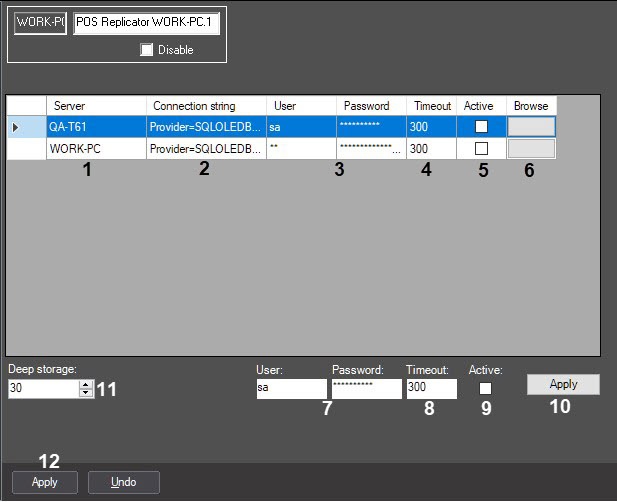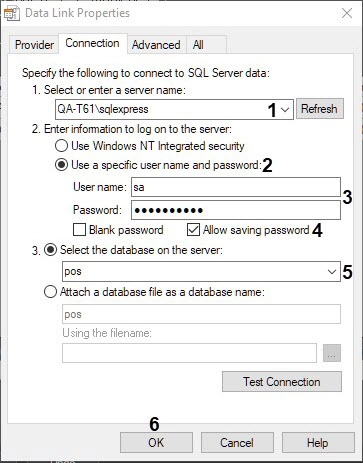Go to documentation repository
Documentation for POS PSIM 1.0.1.
The POS Replicator system object is created on the basis of the Computer object on the Hardware tab of the System settings dialog box. Only one POS Replicator object can be created on the Server.
To configure the POS Replicator system object, do the following:
- Go to the settings panel of the POS Replicator object.
- The Server column (1) displays the names of servers in POS PSIM on which the Servers of databases are run. The list of servers is generated automatically and can’t be edited manually. The server is included in the list only if one or more POS terminal objects are created on it.
- The Connection string column (2) displays the string of connection to remote database server. The string is generated automatically. The name of the SQL server is made from the Server name to which \sqlexpress is added. The default name of database is POS. If it is necessary to change the connection strings, do the following:
- Click the button in the Browse column (6). The Data Link Properties window will open in order to configure the database connection.
- In the Select or enter a server name field, select from the list or enter manually the name of MS SQL Server on which the connected database is stored (1).
- Set the switch into the Use a specific user name and password position (2).
- In the User name field, enter the user name (login) to connect to the MS SQL server, in the Password field, enter the password to access the database (3).
- Set the Allow saving password checkbox (4).
- Select the name of the connected POS database from the Select the database on the server list (5).
- Click the OK button (6) to save changes and return to the settings panel of the POS Replicator object.
- Specify the replication parameters using one of the following way:
- For each server:
- User name and password specified on the step of connection to the database will be automatically entered in the User name and Password fields (3).
- In the Timeout field, enter the data replication period in seconds (4).
- Set the Active checkbox in case replication should be performed from the specified server to the main server (5).
- Repeat steps 4.a.i–4.a.iii for each server in the list.
- If you want to use the same parameters for all servers:
- From the list, select the servers which replication parameters should be changed.
- Enter the user name and password which are used to connect to all databases in the list (7).
- In the Timeout field, enter the data replication period in seconds (8).
- Set the Active checkbox if it is necessary to use all connections (9).
- Click the Apply button (10).
Note
It is possible to specify following parameters for several Servers such way: user name and password of connection to the POS database, timeout and state of replication.
- For each server:
- In the Deep storage field, enter the number of days during which data will be saved in the database (11).
- Click the Apply button (12).
Replication starts automatically when all these actions are completed. Databases with replication time rating are added to the replication queue. Databases with the lowest replication period have the highest priority. Several replication processes can be performed simultaneously depending on the number of cores in the main Server processor.
The replication process can be detected through the terminal window of Pos Aggregator module which is activated by double-clicking the module icon in the tray.
Configuration of the POS Replicator system object is completed.



